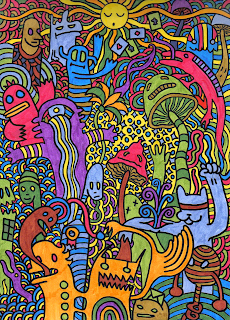Maṇḍala (मण्डल) is a Sanskrit word that means "circle". In the Hindu and Buddhist religious traditions, their sacred art often takes a mandala form. The basic form of most Hindu and Buddhist mandalas is a square with four gates containing a circle with a center point. Each gate is in the shape of a T.
These mandalas, concentric diagrams, have spiritual and ritual significance in both Buddhism and Hinduism. The term is of Hindu origin and appears in the rig Veda as the name of the sections of the work, but is also used in other. Indian relegions, particularly Buddhism. In the Tibetan branch of Vajrayana Buddhism, mandalas have been developed into sandpainting. They are also a key part of anuttarayoga tantra meditation practices.
In various spiritual traditions, mandalas may be employed for focusing attention of aspirants and adepts, as a spiritual teaching tool, for establishing a sacred space, and as an aid to meditation and trance induction. According to David Fontana, its symbolic nature can help one "to access progressively deeper levels of the unconscious, ultimately assisting the meditator to experience a mystical sense of oneness with the ultimate unity from which the cosmos in all its manifold forms arises. The psychoanalyst Carl Jung saw the mandala as "a representation of the unconscious self,"and believed his paintings of mandalas enabled him to identify emotional disorders and work towardswholeness in personality.
Мандала
Круг, сфера, шар, орбита, колесо, кольцо, страна, пространство, совокупность, собрание - вот некоторые значения слова "мандала", встречающиеся в древнеиндийской литературе. В буддизме слово приобрело ряд новых значений: блюдо для подношения в ритуальной практике; мистическая диаграмма, символическое изображение буддийского мироздания, Вселенной. Основное значение термина "мандала" в эзотерическом буддизме - это измерение, мир. Мандала есть символическое изображение чистой земли будд, другими словами, это изображение мира спасения.
Мандала как мистическая диаграмма, как символическое изображение буддийской вселенной представляет собой круг, вписанный в квадрат, который в свою очередь вписан в круг. Внешний круг - Вселенная, внутренний круг - измерение божеств, бодхисаттв или будд. Иногда изображения будд и божеств заменяют изображениями их коренных символов, слогами, чьи звуки выражают измерения этих божеств. Будды, бодхисаттвы и боги держат ритуальные атрибуты; эти предметы, как и формы и позы божеств, символически выражают просветлённую активность реализованных существ, их способности. Место на мандале того или иного бодхисаттвы также соответствует его наиболее развитой способности. Эта способность - просветлённая активность - связана с той или иной из пяти мудростей, символически выражаемых цветом и расположением на мандале. Пять изображаемых будд или бодхисаттв символизируют единство пяти мудростей. У мандалы имеется центр и четыре направления, соответствующие сторонам света. Квадрат мандалы, ориентированный по сторонам света, имеет с каждой стороны Т-образные выходы - ворота во Вселенную. Поле квадрата поделено на четыре части. Пятую часть образует центр. Каждая из пяти частей имеет свой цвет: синий соответствует центру, белый - востоку, желтый - югу, красный - западу, зеленый - северу. Каждый цвет также ассоциируется с одним из дхьяни-будд - главой семейства (генезиса), к которому относится изображаемое существо: синий соответствует Вайрочане, белый - Акшобхье, желтый - Ратнасамбхаве, красный - Амитабхе, зеленый - Амогхасиддхе.
В процессе медитации на стадии порождения практикующий мысленно воспроизводит в себе всё, что изображено на мандале, отождествляя себя с божеством, изображенным в её центре.
Мандалы могут быть как двумерными, изображенными в плоскости, так и объёмными, рельефными. Их рисуют на ткани, на песке, выполняют цветными порошками и делают из металла, камня, дерева. В Тибете их могли вырезать даже из масла, окрашивая его в соответствующие ритуальные цвета. Мандалы часто изображают на полах и на потолках храмов. Некоторые из мандал выполняют из цветных порошков для проведения определённой ритуальной практики, по окончании которой творение разрушают.








